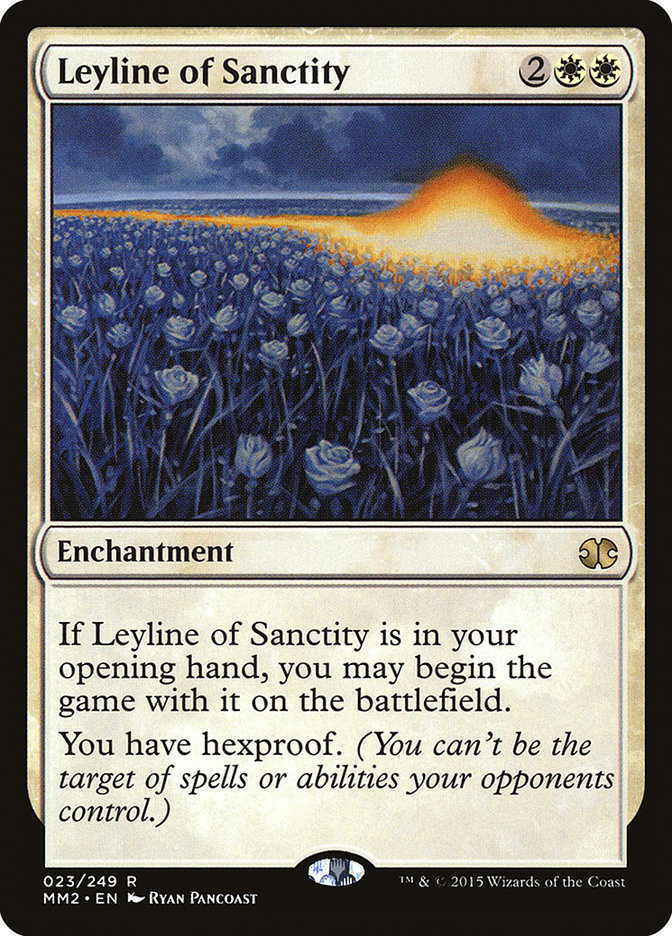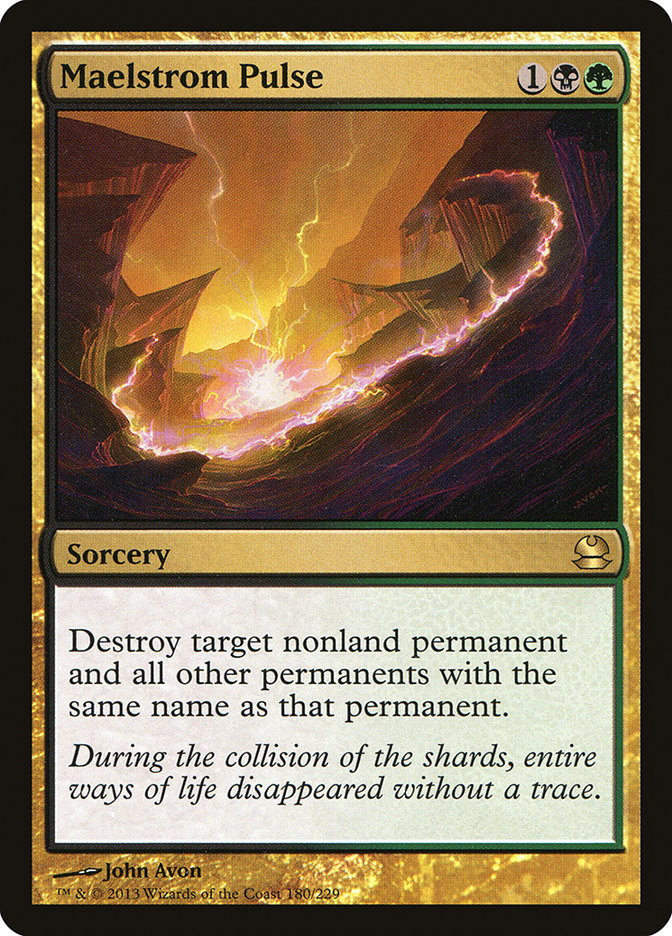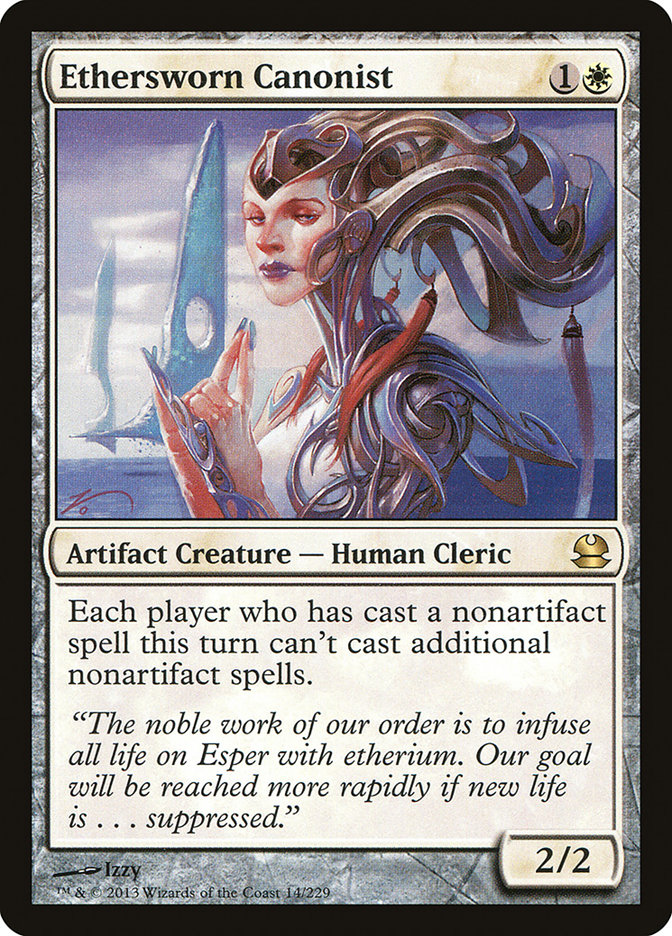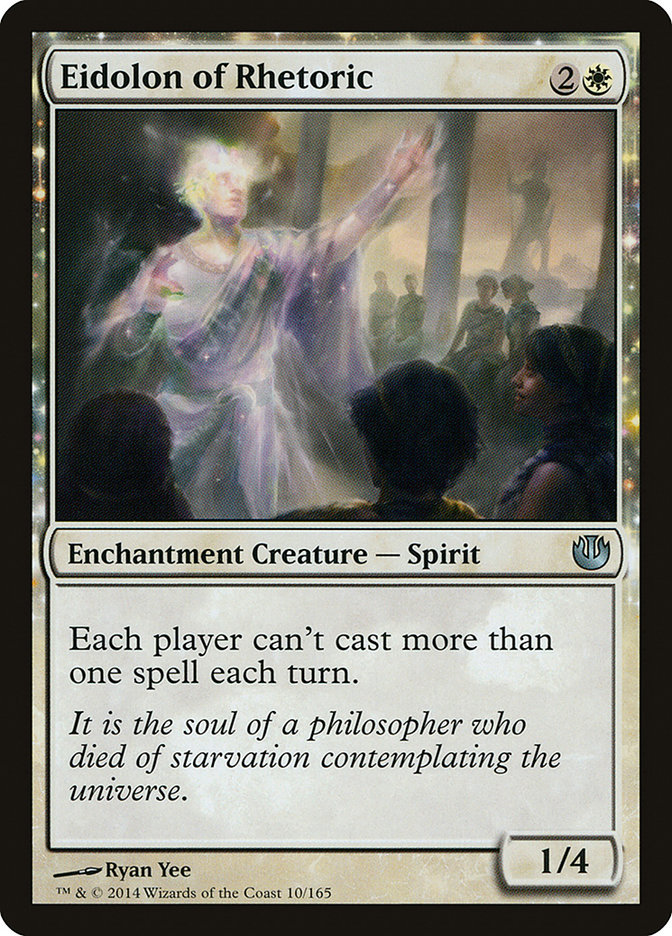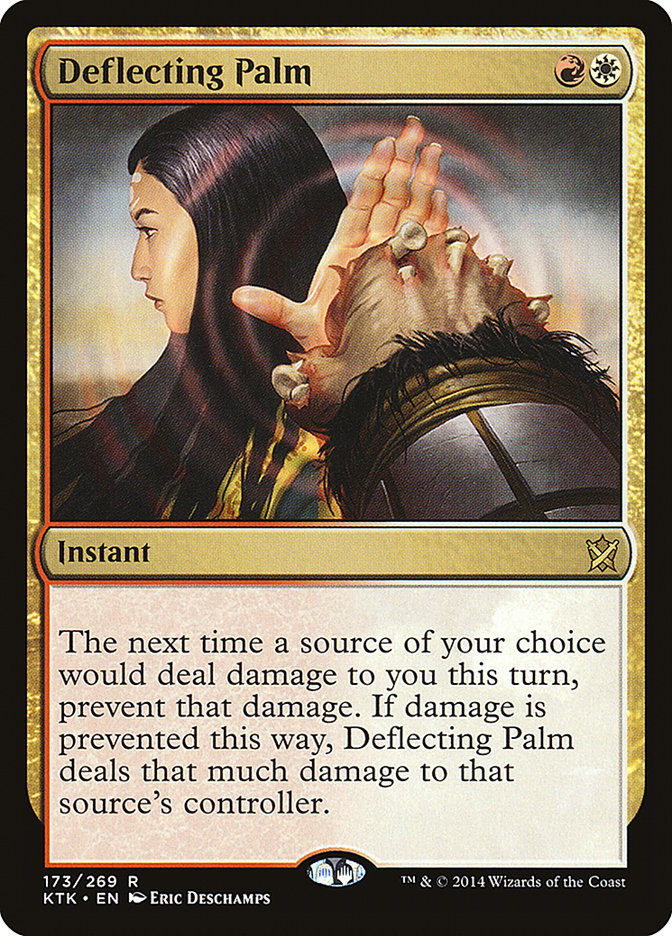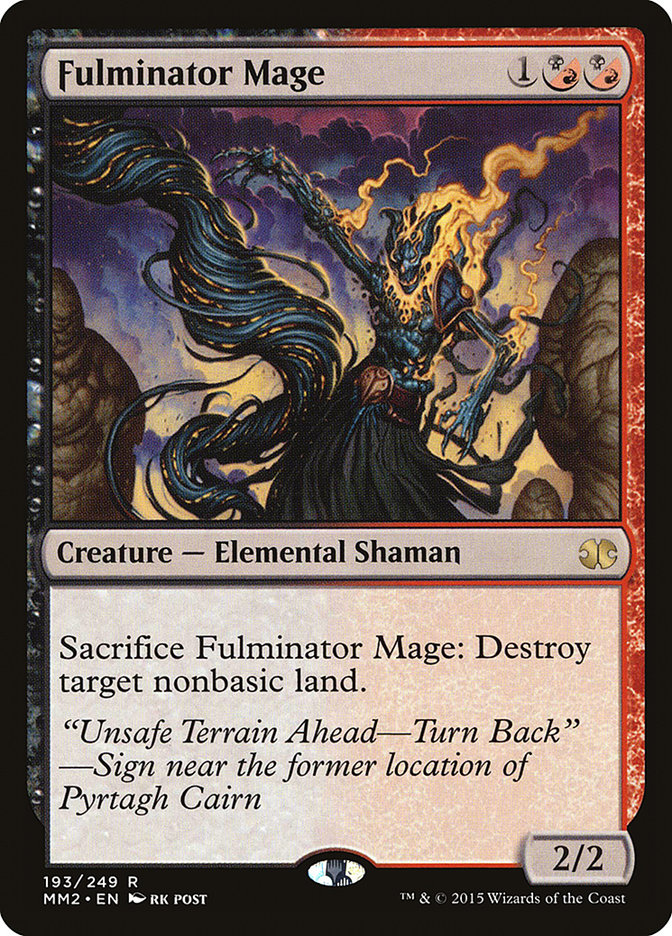With two GPs in one weekend, Vancouver and Brisbane set the stage for what we could expect from Modern with Aether Revolt and the banning of Gitaxian Probe and Golgari Grave-Troll. To my mind, those GPs showed that banning those cards didn’t effectively ban any of the cards they were played with. Infect was still played, Dredge was still played, Death’s Shadow was still played, Storm was still played. I guess Kiln Fiend might be gone, but I was never really impressed with that deck to begin with. Further, while it was far from conclusive, the weekend showed Death’s Shadow as the deck to beat, and demonstrated firmly that graveyard hate shouldn’t be overlooked.
The question for #SCGINDY was whether Death’s Shadow could stay on top despite being targeted. So far, I’d say that despite not winning the event, with two in the Top 8 and nine in the Top 32, it looks like Death’s Shadow is here to stay.
Creatures (13)
Planeswalkers (2)
Lands (18)
Spells (27)

Last week, I wrote about why Death’s Shadow’s so good, how it attacks the rest of the format, and how it might be beaten. Given that the deck is new, fairly complicated, and maybe the most important deck in Modern to understand, I’d like to go over the ins and outs of the matchups you can expect based on the other top performers from #SCGINDY. Note that I won’t be going over exact sideboard plans because I expect the precise build of Death’s Shadow to change over time, and I don’t think there’s an exact consensus about how it should be built yet. Instead, I’m just going to discuss which kinds of cards you want and don’t want, and cards you’d most like to have access to in some spots.
Creatures (4)
Lands (20)
Spells (36)

Nicholas Byrd won the tournament with Ad Nauseam, a deck skilled metagamers expected to be well-positioned due to the decrease in opponents playing Infect, the deck’s worst matchup, and an expected increase in creature removal to combat Death’s Shadow. This is the kind of deck that exists in Modern that really punishes players who play cards that can only kill creatures, and a prime example of why I was reluctant to put even the second Fatal Push in the maindeck of Death’s Shadow.
While I think this deck is broadly well-positioned against a field that’s trying to attack Death’s Shadow, I’m skeptical of its matchup against Death’s Shadow. In the first game, I’d expect Death’s Shadow’s discard and fast clock to tear this deck apart unless the Death’s Shadow player kept a hand with too much creature removal, no discard, or no clock.
After sideboarding, I think the game revolves entirely around Leyline of Sanctity, as the Death’s Shadow player really has no choice but to rely on discard, and if the Ad Nauseam player has Leyline, it blanks a huge portion of the Death’s Shadow player’s deck. I’d expect it to be very difficult for Death’s Shadow to win if the opponent starts with a Leyline of Sanctity.
This is the exact kind of matchup that pros complain about when it comes to Modern. Very little matters other than whether one player draws their sideboard card. From the Death’s Shadow side, the only real answer available to you is to sideboard enchantment removal that can kill Leyline of Sanctity, so notably not Abrupt Decay. The most likely answers are Maelstrom Pulse and Golgari Charm.
Another approach, which I had access to in Vancouver but abandoned for Indianapolis, is to sideboard either Ethersworn Canonist or Eidolon of Rhetoric and try to lock them out that way. It’s not a hard lock, as they do have answers to it, but they might not be able to find one before you can kill them, and it’s extremely hard for them to win while it’s on the battlefield (the best path I can think of is just natural Lightning Storming you to death).
In the near future, I’d put one of those creatures in my sideboard out of respect for this deck, and might also include a card that can destroy Leyline of Sanctity.
Aside from that, there’s not much to the matchup. The most important play advice for the Death’s Shadow player is to be careful with your discard. If you cast it all early, the Ad Nauseam player knows what they need to rebuild, and can use their card selection accordingly. If you wait until right before they can go off, you can take the piece they don’t have redundancy on and minimize their ability to dig for a replacement. Before they go off, their hand isn’t really going anywhere; they’re just casting card selection spells, so there’s really no rush. If you know the matchup, I think I wouldn’t cast a discard spell on turn one unless it’s Inquisition of Kozilek on the play, when I might want to hit Lotus Bloom. (Exceptions for hands where I have a lot of discard or where I’m land-light and know I’ll have to spend my mana on other things for too many turns after that.)
Creatures (14)
Planeswalkers (4)
Lands (22)
Spells (20)

Patrick Tilsen finished second with Abzan, which is rumored to be Death’s Shadow’s worst (common) matchup. The basic problem is that Abzan has too much good removal, so it’s very difficult for Death’s Shadow to build any kind of pressure, and Lingering Souls; Liliana of the Veil; and Scavenging Ooze offer Abzan a late-game that dominates Death’s Shadow’s late-game card advantage. Lingering Souls represents a fast clock that Death’s Shadow has no real answer to outside of Liliana, the Last Hope, and Scavenging Ooze turns off Traverse the Ulvenwald, greatly decreasing Death’s Shadows threats, especially since it can easily keep Tarmogoyf from getting out of hand while growing bigger than the Tarmogoyf.
Game 1 is a complete nightmare for Death’s Shadow. It often feels like it should be close, since the decks have a lot in common, but with so many cards trading so efficiently, it’s extremely unlikely that the game doesn’t go to the late-game and then conclude basically the same way every time, with a victory for Abzan.
In sideboarding, there’s nothing Death’s Shadow can do to end the game quickly, so they have to try to compete in a long game. Adding their own Lingering Souls and Ranger of Eos is huge (I genuinely have no idea how the straight Jund version that Gerry advocates can compete in this matchup, which is not to say it’s wrong to build the deck that way, just that you should recognize that you’re punting this matchup, which is very difficult anyway), but that really only serves to get you closer to parity, and they have a lot of trumps for your Lingering Souls in cards like Scavenging Ooze; Surgical Extraction; Zealous Persecution; Liliana, the Last Hope; and Engineered Explosives.
Further, you’re trying to maximize your card advantage, but Kolaghan’s Command and Liliana, the Last Hope, your primary paths, just don’t really work. They’re often using Path to Exile to answer your threats, so you can’t bring them back, and even when they don’t they have the aforementioned graveyard hate. Beyond that, Kolaghan’s Command just isn’t a good card against them, even in the rare situations where you can successfully return a creature, because it doesn’t answer any of their threats that matter. I’d actually side Kolaghan’s Command out in this matchup, but it makes it really hard to find a way to win.
Ranger of Eos is your best chance by far, but you’re really just hoping to dodge this matchup. I’m really not sure what you could sideboard to fix this if you wanted to. Maybe something like Chandra, Pyromaster, since it’s a planeswalker that doesn’t have a horribly Lingering Souls matchup and can’t be answered by Abrupt Decay or Inquisition of Kozilek, and then you can lean on your discard and Fatal Pushes to answer the opposing creatures to let the game go long enough for Chandra to take over.
Creatures (25)
- 1 Birds of Paradise
- 4 Noble Hierarch
- 4 Drowner of Hope
- 4 Eldrazi Skyspawner
- 4 Eldrazi Displacer
- 4 Reality Smasher
- 4 Thought-Knot Seer
Lands (24)
Spells (11)

Dan Musser finished third with Bant Eldrazi, which has felt like a close matchup to me. Their best assets are Path to Exile, Eldrazi Displacer, and Drowner of Hope. Death’s Shadow’s best asset is the simple fact that their creatures are larger for a fraction of the cost. Eldrazi Displacer is somewhat difficult to kill because it has more than two toughness, and most builds of Death’s Shadow have a very hard time getting Drowner of Hope off the table in Game 1 if it’s cast. Those cards should be the priority targets for discard spells. Because so much of the rest of their deck is creatures that your creatures defeat in combat, I’ve generally been able to use discard to answer those cards and then win by attacking.
In sideboarding, you should cut Kolaghan’s Command because it doesn’t kill their creatures that matter and the matchup isn’t about grinding in that way. They’re answering your creatures through a combination of exiling, tapping, and chump blocking, and the game is about battlefield advantage, not card advantage, so the two-for-one isn’t a priority. You want to add any creature removal you have, and you don’t want grindy cards like Lingering Souls, though you do want Ranger of Eos. 1/1s are too low impact, but Death’s Shadows are very high-impact. Basically, you want to focus on playing cards that have the most impact per mana, rather than card advantage. While Dan Musser didn’t have it, Worship is a card they can sideboard that is very hard to beat if you don’t have enchantment removal, which is another case for Maelstrom Pulse, which is a great card in the matchup regardless of whether they have Worship. Watch out for Blessed Alliance.
Creatures (7)
Lands (22)
Spells (31)

Richie Sledz finished fourth with Grixis Control and beat me in the Swiss as well as Justin Cohen in the Top 8. In Game 1, Grixis Control is advantaged in a very similar way to Abzan. They have enough of the right removal to get to the late-game and a stronger late-game than you. That said, they are leaning heavily on drawing Fatal Push and Terminate and have more cards that don’t work properly, like Lightning Bolt. It’s much easier for you to win a game where they draw the wrong portion of their deck against them than it is against Abzan, which helps a lot in the matchup.
Further, I think you’re actually a pretty heavy favorite after sideboarding. The key here is that all of your card advantage actually works and matters here. Kolaghan’s Command is great in this matchup, Lingering Souls is at its best, and even Fulminator Mage can cause problems for them.
I sideboard differently in this matchup than in most. For reference, this is how I sideboarded against Richie:
Out:
In:
I think it’s probably better not to bring in the Grafdigger’s Cage and to leave one more Thoughtseize in. The idea is that you don’t want so much discard because you’re not looking to trade one-for-one, because that makes the game go long so that they can resolve Ancestral Visions and chain Commands. Instead, you’re looking to present proactive threats that are hard for them to deal with.
Fulminator Mage was fantastic for me just as a 2/2 that they really don’t want to target with a removal spell, and then when I want to try to resolve something, I can sacrifice it to hit their third untapped blue to keep them off Cryptic Command. (Tip: when you want to do this, attack first, and activate Fulminator Mage at end of combat after damage so that they can’t float a mana into your second main phase, and then you can try to resolve your spell.)
After sideboarding, they get to fix their removal, so they can keep you off Tarmogoyf and Death’s Shadow early. This means that their best path after sideboarding is to cast an early Tasigur, the Golden Fang; kill your creatures; and become the aggressor, as you’re favored in the mid-game if they just have to play a reactive early-game. This means that additional cards like Terminate, Dismember, or Liliana of the Veil would be quite good here, and it’s also an argument against cutting Thoughtseize at all. You definitely don’t want Inquisition of Kozilek or Collective Brutality in your deck after sideboarding.
Michael Majors and Justin Cohen finished 5th and 6th with Death’s Shadow. The mirror is tricky. If you discount discard, everyone has more threats than answers, which means that if you’re using discard to protect your threats, an early threat can run away with the game. On the other hand, discard is certainly an answer, rather than a threat, and counting it, players have a lot more answers than threats, which means the games can easily become battles of attrition. The issue is that the battles of attrition in this matchup are basically topdeck battles, since players tear each other’s hands apart, at which point discard becomes fairly bad, except that you can save it until you draw a threat to try to remove the answer your opponent has drawn that they haven’t been able to play.
I think there’s a very good chance that it’s correct to choose draw in this matchup. No one can cast a threat on the first turn (it’s technically possible with Death’s Shadow, but without Gitaxian Probe it basically never happens), so you can’t really come out ahead of discard, and if everything is just trading for one or two mana, being up a card is great.
The worst cards in the mirror are all the red cards. Tarfire doesn’t kill anything, and Kolaghan’s Command doesn’t either. Yes, it’s good in an attrition matchup, but I think it’s just too much mana for too little profit, as it’s almost always Raise Dead plus Raven’s Crime, which is considerably worse than “Raise Dead plus draw a card,” which is just not a good three-mana effect in Modern. Further, some people will bring in Surgical Extraction in the mirror, and using Surgical Extraction is response to Kolaghan’s Command is a huge blowout that I wouldn’t want to expose myself to. Finally, Temur Battle Rage is the kind of narrow card that can easily get stranded that is awful in an attrition game.
I have similar concerns with Surgical Extraction. It can do a lot of great things: you see their hand a lot, so you can use it as another discard spell; they have creature recursion, which you can counter; they have very few different threats, so exiling basically half of them is fairly strong; and you can often counter a Traverse the Ulvenwald by blowing up Delirium in response. Also, it’s a solid answer to Lingering Souls if your opponent brings it in. However, as a card that doesn’t immediately impact the game, it can be a huge liability if you draw it early and your opponent strands you with that and sticks a threat, so I currently think I probably don’t want it, especially if my opponent doesn’t have Lingering Souls.
I want to bring in any removal I have that doesn’t care about toughness; any good grinding cards like Lingering Souls, Ranger of Eos, and planeswalkers; and potentially graveyard hate. Gerry Thompson played Nihil Spellbomb, which sounds like a great card in the mirror match. I’m undecided on Fulminator Mage. I think it’s very good against people who are splashing white, since you can easily permanently take them off the color, but against the straight Jund version I’m not sure. I’d guess that the games go long enough and the curves are low enough that taking them off a land doesn’t do anything, so you don’t want it even though it is a creature that’s good against removal, which can be good in an attrition matchup.
Creatures (13)
Lands (20)
Spells (27)

Garrett Strause played Grixis Delver to an eighth-place finish. I think this matchup is very similar to Grixis Control, except that it’s better for you because Delver of Secrets gives you a good use for your maindeck removal, and the absence of Ancestral Visions and Cryptic Command means you can play a longer game. Your biggest concern here is getting burned out, so you want to carefully manage your life total to try to stay between seven and nine, where your Death’s Shadows can’t be killed by Lightning Bolt and you can’t be killed by two Lightning Bolts.
In this matchup, I think you want more discard rather than Fulminator Mage because your late-game is much better than theirs after sideboarding, unlike against Grixis Control, so you want discard to get to that point, and Fulminator Mage is much weaker because their curve is lower, so there’s less value to killing their lands.
As with Grixis Control, the biggest fear is simply that they stick a Tasigur or Gurmag Angler and kill your creatures, so be careful about keeping a hand that would be weak to that.
Creatures (32)
- 2 Kird Ape
- 2 Simian Spirit Guide
- 4 Wild Nacatl
- 4 Goblin Guide
- 4 Burning-Tree Emissary
- 4 Experiment One
- 4 Reckless Bushwhacker
- 4 Hidden Herbalists
- 4 Narnam Renegade
Lands (17)
Spells (11)
Sideboard

Michael Stewart finished ninth with Revolt Zoo, and I’m pretty sure you’re their worst matchup.
Their deck is a bunch of individually low-impact cards that try to work together to get under their opponents. You’re a bunch of cheap spells that trade with opposing cards and huge blockers. It’s very easy to stop them from building a critical mass of threats to attack around your creatures using discard, Fatal Push, and Tarfire, and then you just want to play conservatively. Be careful to leave plenty of blockers back unless you think you’re in danger of getting burned out. You’re sideboarding minimally. Cut Temur Battle Rage and maybe shave a land or some Street Wraiths and add any cheap removal you have. You’re basically trying to play like a post-sideboard version of Zoo against a tribal deck, where your creatures are independently better and your removal stops theirs from working together to beat that.
Creatures (12)
Lands (19)
Spells (29)

Jason Phimister finished tenth with Burn, which is a matchup I’ve been asked about a lot, but I’ve only played it once. I think it’s very hard for you to win if the burn player draws well, but they don’t have to flood much to lose, since they can’t answer your creatures in Game 1, so as long as you can trade enough resources without paying too much life so that they can’t kill you, your creatures finish things off quickly. Use your fetchlands for tapped lands and basics where possible to preserve your life total. As long as you don’t pay more than five life in a game and stop them from connecting with a creature, it’s pretty hard for them to find the extra four to five spells they need to kill you before a creature kills them if you can trade some discard for some burn spells.
When I played, I made the mistake of leading with a tapped land and falling behind on mana while not saving any life because it let my opponent hit me with a Goblin Guide and needing to spend the mana next turn snowballed out of control fairly quickly, so I’d suggest that while you want to be careful with your shocklands, you should be open to paying for around one per game. Also, to avoid another mistake I made, don’t get cute with your removal. Kill their creatures while they’re tapped out to play around Atarka’s Command and Boros Charm.
After sideboarding, they get Path to Exile and Deflecting Palm. On the one hand, these are very good cards against you. On the other hand, they sit in the Burn player’s hand until you give them the opportunity to use them, slowing down their draw, and potentially letting you make the most of your discard. Because of this, you can actually afford to leave Thoughtseize in your deck while sideboarding, and you’ll find that have to because you probably have too many bad cards and not enough good cards to replace them.
Rounding out the Top 16, the three decks I haven’t covered yet are Abzan Company, G/R Land Destruction, and G/B Tron.
Abzan Company has felt like a surprisingly good matchup. They don’t have any real reach, so you can be pretty reckless with your life total and they have to start chump blocking fairly quickly. Your discard and removal should be able to break up their combos, and at that point their deck is basically just a bunch of chump blockers unless they happen to get very lucky with a Collected Company.
Liliana, the Last Hope is fantastic against them, and Liliana of the Veil is horrible. You want a lot of removal, but you don’t want to give up any pressure to get it, because if the game is about you trying to kill all their creatures, they’ll easily out grind you. You need to make sure the game is about your creatures attacking them, and that your removal is just there to stop them from stealing the game with a combo. Grafdigger’s Cage and Surgical Extraction are excellent here, as they make it extremely difficult for your opponent to combo. You can cut Forest and Temur Battle Rage and trim Traverse the Ulvenwald.
G/R Land Destruction is horrible at dealing with your creatures, but excellent at dealing with your lands. Blood Moon is a real threat; you can fetch basic lands to try to play around it, but that makes it easier for them to stop you from casting spells with Stone Rain. That said, if you have a discard spell and a Tarmogoyf in your opening hand, I think they’re in real trouble.
I’ve sideboarded Fulminator Mage in here to try to keep them off casting their big creatures and because you can cast it through Blood Moon, but I’m not sure that it’s worth it. I think Kolaghan’s Command is pretty bad, since it doesn’t kill their mana creatures quickly enough and making them discard is dangerous because of Obstinate Baloth. I’d also cut Temur Battle Rage (I almost always cut Temur Battle Rage). I’d add any creature removal I had and then Fulminator Mage, and I definitely wouldn’t cut any lands or add any white cards.
I played against G/B Tron and Eldrazi Tron a lot these last two weekends. It’s an interesting matchup; Tron is great against Jund, but horrible against Death’s Shadow, so it can be hard to guess where this matchup would fall. The answer is that I think it’s close, but Death’s Shadow is a little ahead. The fast clock in Death’s Shadow is extremely important, as discard is effective against them only if you give them very few turns to draw what they need. Fulminator Mage works similarly; by itself, it’s not much of a game lan, but if it’s slowing them down so that you can finish them off with a Death’s Shadow, it can easily be enough.
As important as clocking them is, I’d say the one big piece of advice is to prioritize disrupting their game first where possible. If you’re on the play and they cast a Chromatic Sphere (not Chromatic Star) or Expedition Map, if you don’t know their hand, it’s much better to kill it with and Abrupt Decay or Ancient Grudge than to play a Tarmogoyf, because it will usually slow them down by at least a turn, and sometimes it’s a necessary part of their early game.
Sideboarding is pretty straight forward. You want to cut all your horrible creature removal and you want your disruptive elements. Surgical Extraction is good because it lets you potentially keep them off Tron forever with Fulminator Mage. I think you don’t want Collective Brutality because it’s too easy for it to miss. I’ve generally left Liliana, the Last Hope in, even though it’s fairly weak, because recurring Fulminator Mage is a real game plan. It’s possible you only want to try to do this on the play, because it’s extremely slow on the draw.
There are too many decks in Modern to go over all of them, and even choosing which to discuss can be daunting. While the Top 16 from the last tournament isn’t perfectly representative of what you should expect, I’m hoping it offers a solid cross-section of relevant decks, and that I’ve covered enough of the kinds of things you should be thinking about with the deck to extrapolate to figure out how to approach other matchups.


